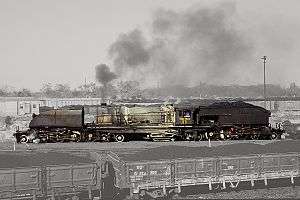4-6-4+4-6-4

In the Whyte notation for the classification of steam locomotives by wheel arrangement, the 4-6-4+4-6-4 is a Garratt articulated locomotive. The wheel arrangement is effectively two 4-6-4 locomotives operating back to back, with the boiler and cab suspended between the two engine units. Each engine unit has two pairs of leading wheels in a leading bogie, followed by three coupled pairs of driving wheels, with two pairs of trailing wheels in a trailing bogie. Since the 4-6-4 type is sometimes known as a Baltic or Hudson, the corresponding Garratt type could be referred to as a Double Baltic or Double Hudson.
Other equivalent classifications are:
- UIC classification: 2C2+2C2 (also known as German and Italian classifications)
- French classification: 232+232
- Turkish classification: 37+37
- Swiss classification: 3/7+3/7 up to the early 1920s, later 6/14
Overview
This was the fifth most common Garratt wheel arrangement, with 84 examples constructed, 74 by Garratt patent owner Beyer, Peacock and ten under sub-contract from Beyer, Peacock by Belgian manufacturer Société Franco-Belge de Matériel de Chemins de Fer in 1952.[1][2]
Only two railway systems used this wheel arrangement. These were the Sudan Railways with ten examples of the 250 class, and the Rhodesia Railways, now the National Railways of Zimbabwe, who owned 74, split between 44 of the 15th class and thirty of the 15A class.[1]
| Gauge | Railway | Class | Works no. | Units | Year | Builder |
|---|---|---|---|---|---|---|
| 3 ft 6 in | Sudan Railways | 250 | 6798–6801 | 4 | 1936 | Beyer, Peacock |
| 3 ft 6 in | Sudan Railways | 250 | 6870–6875 | 6 | 1937 | Beyer, Peacock |
| 3 ft 6 in | Rhodesia Railways | 15th | 6936–6939 | 4 | 1940 | Beyer, Peacock |
| 3 ft 6 in | Rhodesia Railways | 15th | 7228–7237 | 10 | 1947 | Beyer, Peacock |
| 3 ft 6 in | Rhodesia Railways | 15th | 7260–7279 | 20 | 1948–49 | Beyer, Peacock |
| 3 ft 6 in | Rhodesia Railways | 15A | 7326–7340 | 15 | 1949–50 | Beyer, Peacock |
| 3 ft 6 in | Rhodesia Railways | 15A | 7351–7365 | 15 | 1950 | Beyer, Peacock |
| 3 ft 6 in | Rhodesia Railways | 15A | 2963–2972 | 10 | 1952 | Franco-Belge, France |
Usage
Southern Rhodesia

The Rhodesia Railways (RR) 15th class 4-6-4+4-6-4 was the second most numerous class of Garratt locomotives, with seventy-four locomotives built. Only the South African Class GMA 4-8-2+2-8-4 Double Mountain was more numerous at 120 locomotives.[3]
The 15th class was a development of the RR 16th class 2-8-2+2-8-2 Garratts, to meet a requirement for a locomotive with a larger driving wheel diameter for higher speed train service on the more level parts of the railway. After examining the Sudan Railways 250 class, the RR settled on a design with the same wheel arrangement and the same 57 inches (1,448 millimetres) driving wheel diameter as that of the Sudanese Double Baltics.[3]
Initially four locomotives were ordered in 1940, and having proved their worth, a further seventy locomotives were ordered in five batches after World War II. The last forty locomotives were designated as the 15A class, since they had boilers with the rated pressure increased from 180 to 200 pounds per square inch (1.24 to 1.38 megapascals).[3]
Sudan
Ten 4-6-4+4-6-4 Garratt locomotives of the Sudan Railways 250 class were built in two batches for the Sudan Railways by Beyer, Peacock in 1936 and 1937. They were the only Garratt types on the Sudan Railways and were used on the Port Sudan to Atbara and Atbara to Wad Madani routes, until they were made redundant by diesel locomotives in 1949.[3]
They were then sold to the Rhodesia Railways, where they were classified as 17th class and used alongside the RR’s 15th and 15A classes.[3]
In 1964 all ten locomotives were sold to the Caminhos de Ferro de Moçambique, who used them on the Beira railway from the port city of Beira to the Rhodesian (now Zimbabwean) border at Umtali (now Mutare). They remained in use into the 1980s, but their ultimate post-civil war fate is unclear and all of them are presumed to have been scrapped.[3]
References
- 1 2 3 Hamilton, Gavin N., The Garratt Locomotive - Garratt Locomotives produced by Beyer, Peacock, retrieved 10 November 2012
- 1 2 Hamilton, Gavin N., The Garratt Locomotive - Garratt Locomotives from Other Builders, retrieved 10 November 2012
- 1 2 3 4 5 6 7 Durrant, A.E.. Garratt-Lokomotiven der Welt. Birkhäuser Verlag. ISBN 3-7643-1481-8
| Wikimedia Commons has media related to 4-6-4+4-6-4 locomotives. |
| ||||||||||||||||||||||||||||||